My plan is to design a simple game of Pool in Java.
OOP makes the most sense here for the balls. All the balls have the same functionality, so because of that it would be a good idea to make a Ball class that would handle the relative position of the ball and other variables such as when it goes in a hole it removes itself and increments your score. So when it hits a hole Ball.dispose (); would fit nicely.
My issue is that I do not know how to manipulate the ball and dispose of it. Also inorder to move it I rely on Thread.sleep instead of java.swing.timer because there is no available Action Performed method I can rely on.
How can I move the ball more easily and get rid of it when needed?

The green thing covering the ball is my way of erasing the last position of the ball by drawing a green oval over it.
import java.awt.Color;
import java.awt.Graphics;
import javax.swing.JFrame;
public class Main extends JFrame{
Ball redball = new Ball (285, 600, 20, 20, Color.RED);
//variables to control redball
private int rX = redball.getX();
private int rY = redball.getY();
private final int rWidth = redball.getWidth();
private final int rHeight = redball.getHeight();
int Force = 30;
int Bearing = 20; // True Bearing
public Main (){
setSize(600, 800);
setVisible(true);
setDefaultCloseOperation(JFrame.EXIT_ON_CLOSE);
setTitle("Pool");
}
public void paint(Graphics g){
super.paint(g);
// draw the table
g.setColor (Color.GREEN);
g.fillRect(100, 100, 400, 600);
g.setColor (Color.BLACK);
g.drawRect(99, 99, 401, 601);
//draw start ball
g.setColor(redball.getColor());
g.fillOval(rX, rY, rWidth, rHeight);
if (Force == 30){
for (int i = Force; i > 0;i--){
try {
Thread.sleep(100);
} catch(InterruptedException ex) {
Thread.currentThread().interrupt();
}
Force--;
if (rY > 98 + rWidth) {
rY = rY - i;
rX = rX + (Bearing/5);
}
g.fillOval(rX, rY, rWidth, rHeight);
g.setColor(Color.GREEN);
repaint ();
g.fillOval(rX - (Bearing/5), rY + i, rWidth, rHeight); // repaint last ball
g.setColor(Color.RED);
repaint ();
}
}
// Ball.dispose (redball);
}
public static void main(String[] args) {
new Main();
}
Here is the class for the ball
public class Ball {
private int x;
private int y;
private int width;
private int height;
private Color color;
public Ball (int x, int y, int width, int height, Color color)
{
this.x = x;
this.y = y;
this.width = width;
this.height = height;
this.color = color;
}
public void setX (int x){
this.x = x;
}
public int getX (){
return this.x;
}
public void setY (int x){
this.y = y;
}
public int getY (){
return this.y;
}
public void setWidth (int width){
this.width = width;
}
public int getWidth (){
return this.width;
}
public void setHeight (int height){
this.height = height;
}
public int getHeight (){
return this.height;
}
public void setColor (Color color){
this.color = color;
}
public Color getColor (){
return this.color;
}
public static void dispose(Ball ball) {
ball = null; // if I call this method nothing happens
}
}